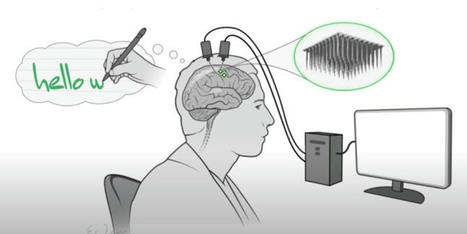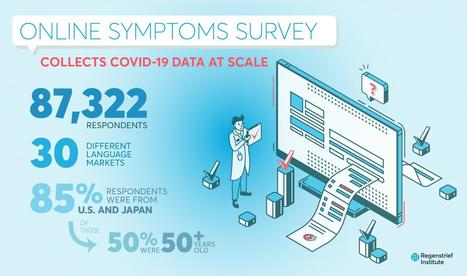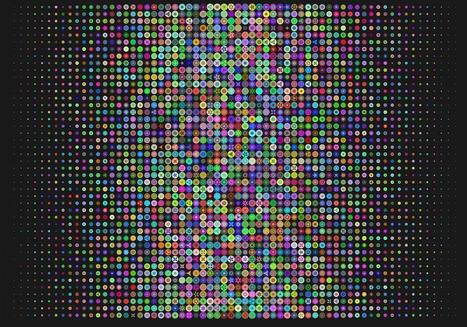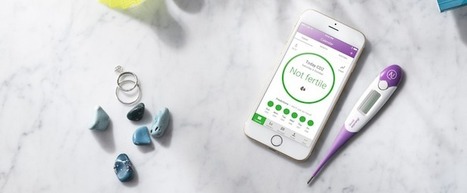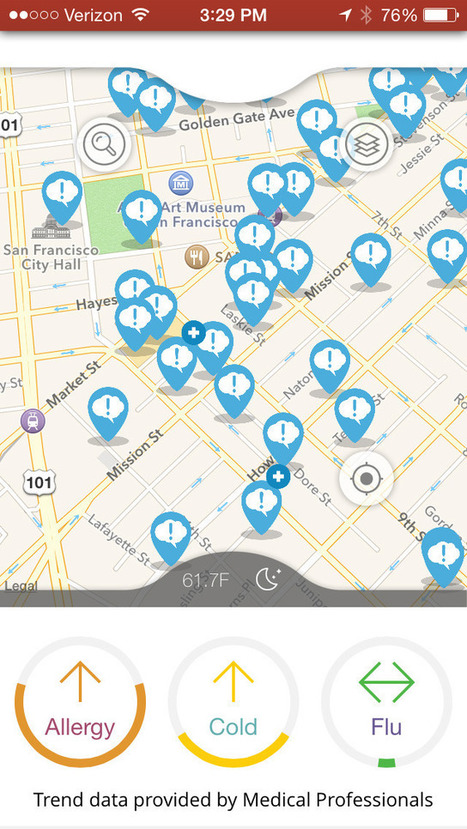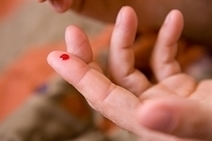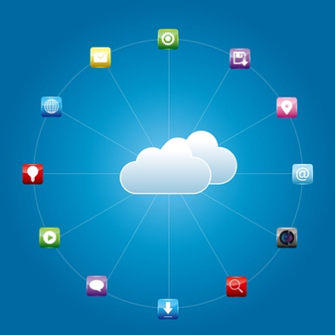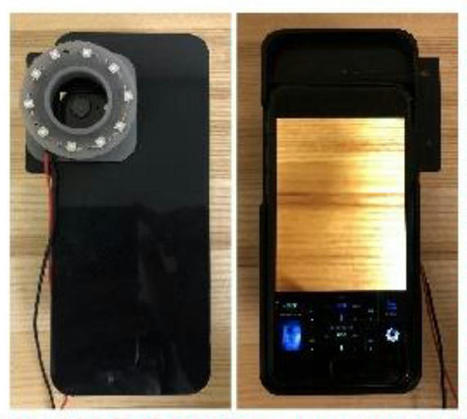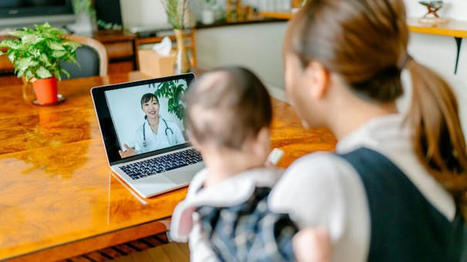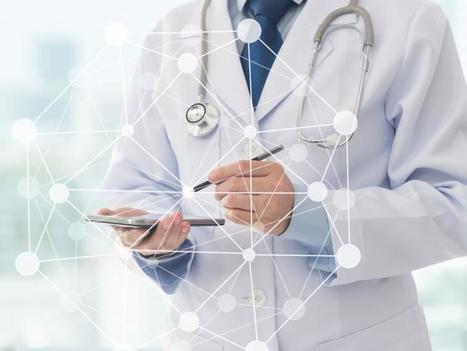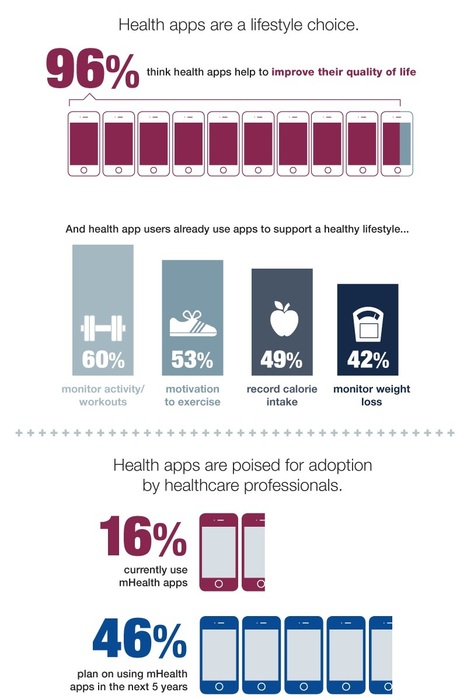 Your new post is loading...
 Your new post is loading...

|
Scooped by
nrip
|
Silicone wristbands are just as good as traditional testing methods at detecting chemicals in the air that can be harmful during pregnancy. Inexpensive, convenient silicone wristbands can measure exposure to a class of chemicals that can be harmful during pregnancy, researchers report. The researchers found that the wristbands, when used as passive samplers, have the ability to bind smaller molecular weight semi-volatile polycyclic aromatic hydrocarbons (PAHs) in a similar pattern as active sampling. PAHs are a class of chemicals that occur naturally in coal, crude oil, and gasoline and are produced when coal, oil, gas, wood, garbage, and tobacco are burned. The use of wristbands is appealing because it is inexpensive and easy to wear,” access the study at https://doi.org/10.1038/s41370-021-00348-y read the original unedited article at https://www.futurity.org/silicone-wristbands-polycyclic-aromatic-hydrocarbons-chemicals-pregnancy-2602202/

|
Scooped by
nrip
|
This week, the academic community provided a rather impressive example of the promise of neural implants. Using an implant, a paralyzed individual managed to type out roughly 90 characters per minute simply by imagining that he was writing those characters out by hand Dreaming is doing Previous attempts at providing typing capabilities to paralyzed people via implants have involved giving subjects a virtual keyboard and letting them maneuver a cursor with their mind. The process is effective but slow, and it requires the user's full attention, as the subject has to track the progress of the cursor and determine when to perform the equivalent of a key press. It also requires the user to spend the time to learn how to control the system. But there are other possible routes to getting characters out of the brain and onto the page. Somewhere in our writing thought process, we form the intention of using a specific character, and using an implant to track this intention could potentially work. Unfortunately, the process is not especially well understood. Downstream of that intention, a decision is transmitted to the motor cortex, where it's translated into actions. Again, there's an intent stage, where the motor cortex determines it will form the letter (by typing or writing, for example), which is then translated into the specific muscle motions required to perform the action. These processes are much better understood, and they're what the research team targeted for their new work. Disclaimer: Not even a prototype As the researchers themselves put it, this "is not yet a complete, clinically viable system." To begin with, it has only been used in a single individual, so we have no idea how well it might work for others. The simplified alphabet used here doesn't contain any digits, capital letters, or most forms of punctuation. And the behavior of the implants changes over time, perhaps because of minor shifts relative to the neurons they read or the build-up of scar tissue, so the system had to be recalibrated regularly—at least once per week to maintain a tolerable error rate read the research at http://dx.doi.org/10.1038/s41586-021-03506-2 related code : https://github.com/fwillett/handwritingBCI read the article in its complete and unedited form at https://arstechnica.com/science/2021/05/neural-implant-lets-paralyzed-person-type-by-imagining-writing/

|
Scooped by
nrip
|
Wearables that have weaved their way into everyday life include smart watches and wireless earphones, while in the healthcare setting, common devices include wearable injectors, electrocardiogram (ECG) monitoring patches, listening aids, and more. A major pain point facing the use of these wearables is the issue of keeping these devices properly and conveniently powered. As the number of wearables one uses increases, the need to charge multiple batteries rises in tandem, consuming huge amounts of electricity. A research team, led by Associate Professor Jerald Yoo from the Department of Electrical and Computer Engineering and the N.1 Institute for Health at the National University of Singapore (NUS), has developed a technology that enables a single device, such as a mobile phone placed in the pocket, to wirelessly power other wearable devices on a user's body, using the human body as a medium for power transmission. The team's novel system has an added advantage—it can harvest unused energy from electronics in a typical home or office environment to power the wearables. The NUS team designed a receiver and transmitter system that uses the human body as a medium for power transmission and energy harvesting. Each receiver and transmitter contains a chip that is used as a springboard to extend coverage over the entire body. A user just needs to place the transmitter on a single power source, such as the smart watch on a user's wrist, while multiple receivers can be placed anywhere on the person's body. The system then harnesses energy from the source to power multiple wearables on the user's body via a process termed as body-coupled power transmission. In this way, the user will only need to charge one device, and the rest of the gadgets that are worn can simultaneously be powered up from that single source. The team's experiments showed that their system allows a single power source that is fully charged to power up to 10 wearable devices on the body, for a duration of over 10 hours. As a complementary source of power, the NUS team also looked into harvesting energy from the environment. Their research found that typical office and home environments have parasitic electromagnetic (EM) waves that people are exposed to all the time, for instance, from a running laptop. The team's novel receiver scavenges the EM waves from the ambient environment, and through a process referred to as body-coupled powering, the human body is able to harvest this energy to power the wearable devices, regardless of their locations around the body. This paves the way for smaller, battery-free wearables read the paper in Nature at http://dx.doi.org/10.1038/s41928-021-00592-y read the original unedited article https://techxplore.com/news/2021-06-approach-wirelessly-power-wearable-devices.html

|
Scooped by
nrip
|
Identifying new COVID-19 cases is challenging. Not every suspected case undergoes testing, because testing kits and other equipment are limited in many parts of the world. Yet populations increasingly use the internet to manage both home and work life during the pandemic, giving researchers mediated connections to millions of people sheltering in place.
Objective: The goal of this study was to assess the feasibility of using an online news platform to recruit volunteers willing to report COVID-19–like symptoms and behaviors.
Methods: An online epidemiologic survey captured COVID-19–related symptoms and behaviors from individuals recruited through banner ads offered through Microsoft News. Respondents indicated whether they were experiencing symptoms, whether they received COVID-19 testing, and whether they traveled outside of their local area.
Results: A total of 87,322 respondents completed the survey across a 3-week span at the end of April 2020, with 54.3% of the responses from the United States and 32.0% from Japan. Of the total respondents, 19,631 (22.3%) reported at least one symptom associated with COVID-19. Nearly two-fifths of these respondents (39.1%) reported more than one COVID-19–like symptom. Individuals who reported being tested for COVID-19 were significantly more likely to report symptoms (47.7% vs 21.5%; P<.001). Symptom reporting rates positively correlated with per capita COVID-19 testing rates (R2=0.26; P<.001). Respondents were geographically diverse, with all states and most ZIP Codes represented. More than half of the respondents from both countries were older than 50 years of age.
Conclusions: News platforms can be used to quickly recruit study participants, enabling collection of infectious disease symptoms at scale and with populations that are older than those found through social media platforms. Such platforms could enable epidemiologists and researchers to quickly assess trends in emerging infections potentially before at-risk populations present to clinics and hospitals for testing and/or treatment.
source: Credit to Regenstrief Institute read the entire study here : https://www.jmir.org/2021/5/e24742

|
Scooped by
nrip
|
A new, noninvasive method for measuring brain blood flow with light has been developed by biomedical engineers and neurologists at the University of California, Davis, and used to detect brain activation. The new method, functional interferometric diffusing wave spectroscopy, or fiDWS, promises to be cheaper than existing technology and could be used for assessing brain injuries, or in neuroscience research. The human brain makes up 2% of our body weight but takes 15% to 20% of blood flow from the heart. Measuring cerebral blood flow is important for diagnosing strokes, and for predicting secondary damage in subarachnoid hemorrhages or traumatic brain injuries. Doctors who provide neurological intensive care, would also like to monitor a patient's recovery by imaging brain blood flow and oxygenation. Existing technology is expensive and cannot be applied continuously or at the bedside. For example, current techniques to image cerebral blood flow require expensive MRI or computed tomography scanners. There are light-based technologies, such as near-infrared spectroscopy, but these also have drawbacks in accuracy. The new method takes advantage of the fact that near-infrared light can penetrate through body tissues. If you shine a near-infrared laser on someone's forehead, the light will be scattered many times by tissue, including blood cells. By picking up the fluctuation signal of the light that finds its way back out of the skull and scalp, you can get information about blood flow inside the brain. read more at https://medicalxpress.com/news/2021-05-brain-blood.html

|
Scooped by
nrip
|
Studies show that Cognitive Behavior Therapy for Insomnia (CBT-I) delivered digitally through mobile phone apps is effective in treating insomnia. Like a real therapist, the apps that use Cognitive Behavior Therapy for Insomnia (CBT-I) also provide practical tools to help the user worry less about their sleep and over time, be less anxious and more confident about their ability get a good night's rest. It's very similar to what physicians do face-to-face with patients, And a recent study of Sleepio by Ong and the team that developed the product found that participants who used the product reported an improvement in insomnia symptoms and overall wellbeing. However, these apps don't work for everyone. The recent study hints at why. Less than 50 percent [of people who were assigned to use the app in a randomized controlled trial] are able to make it through the entire course of CBT delivered through digital platforms, For some people it may be hard to make it through all the sessions of CBT. This is true of most health and wellness apps. In other studies it has been found that of the 10,000 mental health apps out there, very few are actually being used. We dont really understand how people are using technology towards their health and recovery, But in some ways, he says, people with insomnia may be ahead of scientists in figuring out what works well for them. read the original unedited piece at https://www.npr.org/sections/health-shots/2018/10/08/654883409/some-apps-may-help-curb-insomnia-others-just-put-you-to-sleep

|
Scooped by
nrip
|
Information technology has allowed much of our economy to automate processes. We have seen transformations of the airline, banking, brokerage, entertainment, lodging, music, printing, publishing, shipping and taxi industries through the availability of massive volumes of real-time price and service data. Across America, consumer-facing retail service continues to shift to a virtual environment. Healthcare is the exception. Many health information technology (health IT) products initially focused on billing. The misalignment between billing support and the sense that these tools do not materially automate clinician work to build in efficiencies or improve workflows adds to an overall frustration with the increasing amount of time providers spend at their screens. Automation is hard because it tends to require interfaces of various types – both to other machines (Internet of Things) and to humans. Often automation proposals involve solutions that focus on highly structured data. But, someone or something has to put energy (physician salary, for example) into organizing much of this information, assuming it is even knowable. The underlying disease or patient behavior (e.g., smoking) is also often not knowable. And, automation relying on machine to machine interfaces regularly runs into a lack of application programming interfaces (APIs) supporting complex clinical data flows. I posted this week old piece now and now when it was published as #NHITWeek is this week. A lot of posts this week deal with possibilities and problems with healthcare focussed automation. The original unedited piece can be read at https://www.himss.org/news/healthcare-automation-transforming-medicine

|
Scooped by
nrip
|
Digital health is rapidly changing our lives. Almost every day, new developments using data, artificial intelligence and smartphones to improve health, on individual and population levels, are entering the market. In 2015, there were more than 40,000 healthcare apps on Apple's U.S. App Store alone. And the number has kept growing.
But in the process of delivering the next revolutionary technology, health-tech innovators have often neglected to include usability in their apps so that they may also benefit people with disabilities, research suggests
“People with disabilities have a particularly hard time, as they are often overlooked in the design of new technology, both regarding tools and content,” noted a report titled, “Health Inequalities in eHealth Context,” by the European Commission. “Due to their impairment, the notion of them being proficient (information and communications technology) users is often sidelined.”
So, what does this issue look like in the real world?
In August, the U.S. Food and Drug Administration approved the marketing of the first mobile health (mHealth) app for contraception: Natural Cycles. The app allows women to avoid pregnancy by monitoring their resting body temperature — known as the basal body temperature — and recording their data so that an algorithm can determine their daily fertility.
With “perfect use,” the app’s creators say the failure rate is 1.8 percent, which means that 1.8 in 100 women annually will become pregnant despite using the technology.
But although the app meets the FDA’s guidelines governing mHealth apps, Natural Cycles poses problems for some nontraditional eHealth users, including women who have disabilities or irregular periods. read the whole story at https://www.hcanews.com/news/natural-cycles-is-the-first-fdaapproved-contraception-app-but-its-not-for-all-women

|
Scooped by
nrip
|
People don’t crave the latest fitness wearable. Their overwhelming preference is for simple applications that provide and organize information Startups in the insurance industry are investing feverishly to roll out products and services that will appeal to consumers. Taking a cue from the technology and communications industries, many are pursuing disruptive technologies that promise to revolutionize the healthcare experience — whether digestive sensors or systems that allow doctors to examine and treat patients via video. But here’s the thing: Consumers aren’t ready for a revolution. They have far simpler demands and desires, such as an easier way to schedule doctor visits or the ability to get follow-up notifications on a mobile phone. As a result, insurers that want to make the most of their investments in new technologies should focus their resources on developing simple digital products and services that align with their identities, strategic goals, and existing capabilities. The idea that customers prefer simplicity may not come as a shock to those outside the healthcare industry. But it’s likely a revelation to those in the business, especially the insurers who have been investing heavily in telemedicine and other advanced features. The survey revealed further insights into consumers’ preference for simplicity and a streamlined experience. Some 97 percent of respondents said they would be willing to share personal health data and nonsensitive information if it would enhance their care, and only 3 percent ranked data privacy as the most important feature of a health plan. About half of consumers want to involve both providers and insurers in their healthcare, and consumers are becoming increasingly comfortable with receiving wellness advice from health plans. That makes sense given the growth of so-called consumer-directed health plans, which put more responsibility for healthcare decisions and costs on consumers. more at http://www.strategy-business.com/article/What-Consumers-Most-Want-from-Health-Insurers-Technology

|
Scooped by
nrip
|
The worst part of a sniffle or a sore throat is wondering what it is you're coming down with
A new app, called HEALTHYDAY, comes from a division of Johnson & Johnson and uses sickness-searching algorithms to take the guesswork out of your hypochondria by warning you when the flu is overtaking your neighborhood or pollen is driving allergies sky-high. as a kind of subtle advertising for its products.
The basic health tips the app offers up don't outright tell you which medicines to buy — instead they are each "brought to you" by one of the company's over-the-counter brands, which include Zyrtec and Tylenol.
The app's algorithm syncs self-reported data from local doctor's offices, Google searches, social media mentions on Twitter and Facebook and user data from people who use the app, then funnels it down into easily digestible trends, blurbs and infographics, according to McNeil's VP of marketing Katie Devine.
In San Francisco, for example, the app warns of a particularly high risk of allergies and cold symptoms and a middling likelihood of the flu. The team wants to expand the app's features with more ailments and information once it has a bigger user base.

|
Scooped by
nrip
|
New technology developed by Howard Hughes Medical Institute (HHMI) researchers makes it possible to test for current and past infections with any known human virus by analyzing a single drop of a person's blood. The method, called VirScan, is an efficient alternative to existing diagnostics that test for specific viruses one at a time, according to the scientists.
With VirScan, researchers can run a single test to determine which viruses have infected an individual, rather than limiting their analysis to particular viruses.
That unbiased approach could uncover unexpected factors affecting individual patients' health, and also expands opportunities to analyze and compare viral infections in large populations. The analysis reportedly can be performed for about $25 per blood sample. “We've developed a screening methodology to basically look back in time in people's sera and see what viruses they have experienced,” says Stephen J. Elledge, an HHMI investigator at Brigham and Women's Hospital who led an international team that developed VirScan. “Instead of testing for one individual virus at a time, which is labor intensive, we can assay all of these at once. It's one-stop shopping.”
VirScan works by screening the blood for antibodies against any of the 206 species of viruses known to infect humans. The immune system produces pathogen-specific antibodies when it encounters a virus for the first time, and it can continue to make those antibodies for years or decades after it clears an infection. That means VirScan not only identifies viral infections that the immune system is actively fighting, but also provides a history of an individual's past infections.

|
Scooped by
nrip
|
Your smartphone is not only your best friend, it's also become your personal trainer, coach, medical lab and maybe even your doctor.
"Digital health" has become a key focus for the technology industry, from modest startups' focus on apps to the biggest companies in the sector seeking to find ways to address key issues of health and wellness.
Apps that measure heart rate, blood pressure, glucose and other bodily functions are multiplying, while Google, Apple and Samsung have launched platforms that make it easier to integrate medical and health services.
"We've gotten to a point where with sensors either in the phone or wearables gather information that we couldn't do in the past without going to a medical center," says Gerry Purdy, analyst at Compass Intelligence.
"You can do the heart rate, mobile EKGs (electrocardiograms). Costs are coming down, and these sensors are becoming more socially acceptable."
The consultancy Rock Health estimates 143 digital health companies raised $2.3 billion in the first six months of 2014, already topping last year's amount.
Recent studies suggest that people who use connected devices to monitor health and fitness often do a better job of managing and preventing health problems.
A study led by the Center for Connected Health found that people who use mobile devices did a better job of lowering dangerous blood pressure and blood sugar levels.
A separate study published in the July 2014 issue of Health Affairs found that data collected by devices is not only useful for patients but can help doctors find better treatments.
"When linked to the rest of the available electronic data, patient-generated health data completes the big data picture of real people's needs, life beyond the health care system," said Amy Abernethy, a Duke University professor of medicine lead author of the study.
Some firms have even more ambitious plans for health technology.
Google, for example, is developing a connecting contract lens which can help monitor diabetics and has set up a new company called Calico to focus on health and well-being, hinting at cooperation with rivals such as Apple. And IBM is using its Watson supercomputer for medical purposes including finding the right cancer treatment.
Read more at: http://phys.org/news/2014-07-mobile-tech-reshaping-health-sector.html#jCp

|
Scooped by
nrip
|
A recent international survey by the McKinsey & Company consulting firm addresses some myths about consumer use of digital healthcare services.
Many healthcare executives believe that, due to the sensitive nature of medical care, patients don’t want to use digital services except in a few specific situations. Decision makers often cite relatively low usage of digital healthcare services. Results of this survey however reveal something quite different.
The 5 myths debunked by this survey are as follows Myth 1: People don’t want to use digital services for healthcareMyth 2: Only young people want to use digital services Myth 3: Mobile health is the game changerMyth 4: Patients want innovative features and appsMyth 5: A comprehensive platform of service offerings is a prerequisite for creating value
More at http://www.healthdatamanagement.com/gallery/5-myths-about-consumer-use-of-digital-healthcare-services-48388-1.html
|

|
Scooped by
nrip
|
A new diagnostic technique that has the potential to identify opioid-addicted patients at risk for relapse could lead to better treatment and outcomes. Using an algorithm that looks for patterns in brain structure and functional connectivity, researchers were able to distinguish prescription opioid users from healthy participants. If treatment is successful, their brains will resemble the brain of someone not addicted to opioids. “People can say one thing, but brain patterns do not lie,” says lead researcher Suchismita Ray, an associate professor in the health informatics department at Rutgers School of Health Professions. “The brain patterns that the algorithm identified from brain volume and functional connectivity biomarkers from prescription opioid users hold great promise to improve over current diagnosis.” In the study in NeuroImage: Clinical, Ray and her colleagues used MRIs to look at the brain structure and function in people diagnosed with prescription opioid use disorder who were seeking treatment compared to individuals with no history of using opioids. The scans looked at the brain network believed to be responsible for drug cravings and compulsive drug use. At the completion of treatment, if this brain network remains unchanged, the patient needs more treatment. read the study at https://doi.org/10.1016/j.nicl.2021.102663 read the article at https://www.futurity.org/opioid-addiction-relapse-algorithm-2586182-2/

|
Scooped by
nrip
|
Researchers have figured out a way to use images from a smartphone to identify potentially harmful bacteria on the skin and in the mouth. A new method that uses smartphone-derived images can identify potentially harmful bacteria on the skin and in the mouth, research shows. The approach can visually identify microbes on skin contributing to acne and slow wound healing, as well as bacteria in the oral cavity that can cause gingivitis and dental plaques. Researchers combined a smartphone-case modification with image-processing methods to illuminate bacteria on images taken by a conventional smartphone camera. This approach yielded a relatively low-cost and quick method that could be used at home. The team augmented a smartphone camera’s capabilities by attaching a small 3D-printed ring containing 10 LED black lights around a smartphone case’s camera opening. The researchers used the LED-augmented smartphone to take images of the oral cavity and skin on the face of two research subjects. The LED lights ‘excite’ a class of bacteria-derived molecules called porphyrins, causing them to emit a red fluorescent signal that the smartphone camera can then pick up Other components in the image—such as proteins or oily molecules our bodies produce, as well as skin, teeth, and gums—won’t glow red under LED. They’ll fluoresce in other colors. The LED illumination gave the team enough visual information to computationally “convert” the RGB colors from the smartphone-derived images into other wavelengths in the visual spectrum. This generates a “pseudo-multispectral” image consisting of 15 different sections of the visual spectrum—rather than the three in the original RGB image. Obtaining this visual information up front would have required expensive and cumbersome lights, rather than using the relatively inexpensive LED black lights With their greater degree of visual discrimination, the pseudo-multispectral images clearly resolved porphyrin clusters on the skin and within the oral cavity. In addition, though they tailored this method to show porphyrin, researchers could modify the image-analysis pipeline to detect other bacterial signatures that also fluoresce under LED. read the study at https://doi.org/10.1016/j.optlaseng.2021.106546 read the original unedited article at https://www.futurity.org/smartphone-images-skin-mouth-bacteria-2581642/

|
Scooped by
nrip
|
Neurological disorders such as Parkinson's disease and epilepsy have had some treatment success with deep brain stimulation, but those require surgical device implantation. A multidisciplinary team at Washington University in St. Louis has developed a new brain stimulation technique using focused ultrasound that is able to turn specific types of neurons in the brain on and off and precisely control motor activity without surgical device implantation. The team, led by Hong Chen, is the first to provide direct evidence showing noninvasive, cell-type-specific activation of neurons in the brain of mammal by combining ultrasound-induced heating effect and genetics, which they have named sonothermogenetics. It is also the first work to show that the ultrasound- genetics combination can robustly control behavior by stimulating a specific target deep in the brain. Results of the three years of research, which was funded in part by the National Institutes of Health's BRAIN Initiative, were published online in Brain Stimulation May 11, 2021. "Our work provided evidence that sonothermogenetics evokes behavioral responses in freely moving mice while targeting a deep brain site," Chen said. "Sonothermogenetics has the potential to transform our approaches for neuroscience research and uncover new methods to understand and treat human brain disorders." more at https://medicalxpress.com/news/2021-05-tool-deep-brain-neurons-combining.html

|
Scooped by
nrip
|
The pandemic drove many patients to their primary care docs via video. And it worked. A telehealth expert (Dr. Peter Antall) explains how this shift could become a permanent hybrid with in-person care in an Interview with healthcareITNews Here is a summary from the interview. What is Virtual Primary Care Virtual primary care is allowing patients to see their primary care physician in person or virtually, depending on their needs. It combines the convenience of telehealth with the ability to strengthen recurring relationships with primary care physicians. It also can help provide a medical home for patients who have no primary care physician, either due to lack of access or lack of engagement. The emergence of virtual primary care stems from the recognition that the traditional primary care model doesn't work well for many patients. Access to care remains a major issue for many patients, due to geographical constraints and a growing shortage of primary care physicians, which has only been exacerbated by the pandemic. Do Patients Want it? Patients are receptive. A recent Amwell survey shows consumers want a virtual approach to primary care – - Most consumers (77%) would prefer to see their existing primary care provider via video.
- 25% of consumers are willing to switch providers to get it.
- 80% saying they would prefer to see the same primary care physician regularly via virtual care.
Can virtual primary care provide a simple, seamless care experience? How are patients supported throughout the care process? The best virtual primary care programs are well coordinated and enable a seamless care experience with the ability to transition patients between in-person and virtual care settings, and to various specialties or allied care providers as needed. In this way the care is holistic and the patient journey is clear and simple. Data sharing is an important part of creating a highly coordinated and seamless care experience. Records from all visits should be available to all providers on the telehealth platform across specialties and should be shared with the primary care physician in brick and mortar if one exists. This interoperability improves care and improves the referral and transition process. To ensure patients are supported, virtual primary care programs should include care coordination capabilities. For example, secure messaging between patients, healthcare professionals and administrative staff can help patients receive quick answers to their questions and ensure that all of their needs are met in a timely fashion, even after a visit has finished. Can virtual primary care help with population health? The flexibility of remote access makes it possible for providers to see patients' living conditions, evaluate social determinants of health, and respond in ways that make a deep impact on patients' lives. Providers also can leverage virtual primary care to evaluate medication adherence among patients with diabetes, hypertension and high cholesterol. When breakdowns in medication adherence are discovered, providers and support staff can work to engage patients in following their treatment plan more closely. This avoids complications that can occur when patients deviate from recommended treatment. Improvements in compliance and ongoing care can be accomplished through use of frequent brief touchpoints, care coordination, nudges and team-based care. Prompts and reminders can be used to reinforce the care plan. With capabilities such as these, virtual primary care positions providers and health plans not only to improve population health, but also to perform well under value-based models of care. More and more, it's clear that the future of care depends on hybrid models of care delivery such as this and I believe we've only just begun to scratch the surface of what's possible with virtual primary care and how it contributes to the continued transformation of healthcare. read the unedited article on the interview at https://www.healthcareitnews.com/news/will-virtual-primary-care-become-new-model-healthcare-delivery

|
Scooped by
nrip
|
- The world's largest technology companies have all hired well-known cardiologists.
- Heart disease and high blood pressure affect a large number of people, are well-understood, and there's evidence that consumer products can help.
Big Silicon Valley companies have often competed for talent with specialized skills, like expertise in artificial intelligence or trendy new programming languages. Now they're competing for heart doctors. Apple, Alphabet, and Amazon have all hired well-known cardiologists. This might just be a coincidence. Cardiologists tend to be well educated and hard working, and big tech companies have a track record of recruiting such people. In recent years, all of these companies have started to invest in products and devices that are targeted to millions of people who could benefit by tracking their heart health. Apple's smartwatch now includes an electrocardiogram, which can detect heart rhythm irregularities. Verily's study watch, which is designed for clinical trial research, also tracks heart rate and heart rhythm, and it's doing a lot of work in chronic disease management. So the more likely explanation is that tech companies are interested in health care, and they have all come to the conclusion that cardiology should be an early (if not initial) target. Here's why. It's a huge potential market Heart disease is the No. 1 killer in the world, and strokes are among the leading causes of death. And that's not all that cardiologists treat. "Our scope covers other common disease such as high blood pressure, which impacts about a third of people in the U.S. — 75 million Americans — as well as lipid and cholesterol disorders," said Dr. Mo Elshazly, a cardiologist and assistant professor of medicine at Weill Cornell Medicine. Many cardiologists are also experts in nutrition and exercise science, which impacts a huge number of people who are committed to staying healthy. That's useful for the teams within the largest tech companies that are more focused on wellness and fitness applications, rather than on health and medical. Alphabet has Google Fit. Apple has a fitness group for its Apple Watch. And Amazon is looking at health and wellness applications for its Alexa voice assistant. It's well-studied Cardiology is among the most-studied fields in medicine, meaning there's already a lot of evidence to understand the root causes of heart disease, as well as how to prevent it. That's attractive for tech companies, which tend to base their development decisions on data. Their consumer products are already making a difference Let's take Apple, as an example. The company launched its first Apple Watch model with a heart rate sensor, never expecting that people would use it to discover they were pregnant, at risk for a heart attack or experiencing a dangerous irregular heart rhythm. But as people began sharing examples of how the Apple Watch saved their life, the company started to invest heavily in the science and technology to drive more of these stories. A lot of that work culminated in the first-ever clearance for a heart rhythm sensor called an ECG for Apple Watch earlier in the summer. read more at https://www.cnbc.com/2018/10/17/what-every-tech-company-needs-a-cardiologist.html

|
Scooped by
nrip
|
As the Internet of Things (IoT) and other emerging technologies continue to proliferate in healthcare, BlackBerry has developed a set of technologies to help leverage these technologies while prioritizing data security. The first of these tools is a blockchain solution, powered by the company's network operation center (NOC), that aims to facilitate safer storage and transfer of medical data, the release said. For example, the data could be anonymized for use in medical research, it noted. BlackBerry will be offering its blockchain tool to the Global Commission, an organization focused on eradicating rare diseases in children, the release said. The Global Commission hopes to use the tool to create real-time insights that will speed diagnoses. "We are applying our expertise in security, data privacy, and communication work in regulated industries such as automotive, financial services, and government to tackle one of the biggest challenges in the healthcare industry: leveraging healthcare endpoints to improve patient outcomes while ensuring security and data privacy," BlackBerry CEO John Chen said in a press release. read the original unedited piece at https://www.techrepublic.com/article/blackberrys-new-blockchain-tools-could-boost-security-for-medical-iot/

|
Scooped by
nrip
|
A lot of startups are starting to offer mobile tools to serve as “first lines of defense” for concerned consumers. A natural extension to patient education, they serve as the first line of diagnosis. Dermatology is a particularly attractive area for this because of a national shortage of dermatologists in the United States. Clinical decision support tool maker VisualDx officially launched Aysa, its first consumer-facing app, last month at Health 2.0 in San Francisco. The app allows users to upload pictures of skin lesions or rashes, enter some additional information about themselves and receive suggestions of what condition they might have and what actions to take next. VisualDx stands out as a company that’s moving from provider-focused clinical decision support into the consumer world, which should lend it more credibility to its platform. The app uses machine learning to identify skin conditions and make treatment suggestions. services like this are crucial, even acknowledging their limitations, because people are already looking online for medical answers, so they might as well have the best ones possible. CEO Dr. Art Papier in conversation with MobiHealthNews said “We know that everybody searches Google with their symptoms or they go to WebMD and use a symptom checker,” he said. “So the real question is how do you develop something that’s an educational symptom checker that’s safe? The art of this is to do a better job of educating so people know on a weekend, do I need to run to urgent care on a weekend, or can I get some better information that will help me make some decisions and then I’ll see the doctor later if necessary.” read the original story at https://www.mobihealthnews.com/content/visualdx-launches-aysa-consumer-facing-dermatology-app

|
Scooped by
nrip
|
A survey conducted by Nielsen on behalf of the Council of Accountable Physician Practices (CAPP) finds that, at most, 52 percent of primary care physicians have recommended that their patients use an mHealth app or device to track their health. Yet only 4 percent to 5 percent of consumers surveyed say their PCP has made such a recommendation This means that either physicians are making the effort but their patients are ignoring the advice, or patients are looking for that guidance but it isn’t coming from their doctors. the survey reached a familiar conclusion in how each generation perceives mHealth and telehealth. It found that consumers rarely use video visits (only 5 percent total), but those age 34 and younger are twice as likely to use and want them than those age 65 and older. The same discrepancy was seen in the use of text reminders for medication and health measurements and online scheduling tools. more at : http://mhealthintelligence.com/news/do-doctors-patients-take-mhealth-seriously

|
Scooped by
nrip
|
A new survey shows 96% of mobile health application users and medical professionals believe mobile health apps "improve their quality of life."
Meanwhile, 86% of providers surveyed said mobile health apps will improve their knowledge of patients' medical conditions.
For the survey, researchers polled 1,000 mobile health app users and 500 medical professionals.
Overall, the survey found that 96% of surveyed mobile health users and medical professionals said that mobile health apps "improve their quality of life."
Among mobile health app users, the survey found: - 60% use apps to monitor activity/workouts (Gruessner, mHealth Intelligence, 6/12);
- 53% use apps as motivation to exercise;
- 49% use apps to record calorie intake; and
- 42% use apps to monitor weight loss (Research Now survey, June 2015).
Among surveyed health care professionals, the survey showed:
- 86% knowledge believe mobile health apps will increase their of their patients' medical conditions;
- 76% believe the apps will help patients with chronic disease management (mHealth Intelligence, 6/12);
- 61% believe the apps will help those who are at a high risk of developing health issues;
- 55% believe the apps could help healthy individuals stay healthy;
- 48% believe the apps could help patients recently discharged from a hospital; and
- 46% believe the apps will improve their relationship with their patients.
more at http://www.ihealthbeat.org/articles/2015/6/15/most-mhealth-app-users-providers-feel-apps-improve-quality-of-life

|
Scooped by
nrip
|
In a study it was concluded that Web-based questionnaires can be used to validly collect data on many chronic disorders, allergies, and blood pressure readings among pregnant women
The aim of the said study was to assess the validity of a Web-based questionnaire on chronic medical conditions, allergies, and blood pressure readings against obstetric records and data from general practitioners.
The background of the said study is that Self-reported medical history information is included in many studies. However, data on the validity of Web-based questionnaires assessing medical history is scarce. If proven to be valid, Web-based questionnaires may provide researchers with an efficient means to collect data on this parameter in large populations
Self-reported questionnaire data were compared with obstetric records for 519 pregnant women participating in the Dutch PRegnancy and Infant DEvelopment (PRIDE) Study from July 2011 through November 2012.
These women completed Web-based questionnaires around their first prenatal care visit and in gestational weeks 17 and 34. We calculated kappa statistics (κ) and the observed proportions of positive and negative agreement between the baseline questionnaire and obstetric records for chronic conditions and allergies.
In case of inconsistencies between these 2 data sources, medical records from the woman’s general practitioner were consulted as the reference standard. For systolic and diastolic blood pressure, intraclass correlation coefficients (ICCs) were calculated for multiple data points.
more at http://www.jmir.org/2015/6/e149/

|
Scooped by
nrip
|
As practices look to integrate newer and hopefully advanced technologies to help them reduce readmission rates and improve outcomes, there is a lot to consider.
Buzzwords abound, like big data and coordinated care, but what those things actually mean vary largely from one place to the next.
ECRI Institute’s 2015 Top 10 Hospital C-Suite Watch List discusses a blend of novel, new, and emerging technologies that will demand attention and planning over the next 12 to 18 months, plus important issues and programs affecting care processes and delivery in 2015 and beyond.

|
Scooped by
nrip
|
As tech giants like Apple, Google and Samsung compete over dominance in the healthcare market, with their latest platforms and apps, the question remains will any or all of these innovations truly tap into the greater realm of consumer health? Aside from the buzz now emanating from consumers’ pockets, is there a real signal being sent out here about how to change healthcare, or will these latest consumer-concentric technologies add nothing more than noise?
Welltok's Scott Rotermund explains that what we really need from Google Fit and HealthKit is an integrated approach that not only collects data, but also meshes with the current healthcare ecosystem.
What lessons learned from the disappointments associated with the consumer use of FitBit and others tell us about behavior change? We’ve learned two things:
1. A cool gadget is not enough – The novelty will wear off along with the use of the wearable. In my experience, most people lose interest in their tracking device after a month – they learn their sleep patterns, know average steps, etc. To maintain usage, we’ve tied tracking devices to challenges, participatory incentives and personalized action plans with defined goals.
2. Relying on the consumers to take action – With the startling statistics associated to preventable diseases like obesity and diabetes, it’s safe to say that we cannot expect consumers to take action on their own. These big tech giants are treating health activities as they would consumer electronics – the same rules don’t apply. To move beyond early adopters, they need to tie into programs that provide personalized guidance on how to use the trackers and the resulting data, and align those defined actions with the right incentives to get people moving.
more at http://hitconsultant.net/2014/07/22/is-integration-the-key-to-google-fit-and-healthkits-success/
|



 Your new post is loading...
Your new post is loading...




